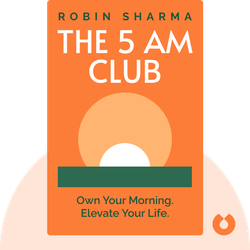Try Blinkist to get the key ideas from 7,000+ bestselling nonfiction titles and podcasts. Listen or read in just 15 minutes.
Start your free trial
Blink 3 of 8 - The 5 AM Club
by Robin Sharma

Vipassana Meditation as Taught by S. N. Goenka
"The Art of Living" by William Hart offers insight into the teachings of Vipassana meditation, providing a path to inner peace and self-discovery through self-awareness and mindfulness practices.
There’s a story about a young professor on a ship at sea. Every night, an illiterate old sailor would visit the young professor’s cabin and listen to him talk about many different subjects.
Night after night, the professor would ask the old sailor if he’d ever studied subjects like geology, meteorology, and oceanography. The answer would always be “no.” And the professor would tell the poor old sailor that he’d wasted his life.
Then, one night, the sailor had a question for the professor. He asked him, “Have you ever studied swimology?” The professor was baffled. “Can you swim?” the old sailor asked. The professor couldn’t swim. And, as the ship had just struck a rock, he drowned, while the old sailor survived.
The lesson here is that no amount of study can replace practical experience. When it comes to Buddhism, the same is true. Buddhism will only have a positive effect on your life if you apply its lessons on a daily basis.
The key message here is: You can only benefit from Buddhism through practical application.
The whole point of the Buddha’s teachings is practical application in the here and now. It’s not just intellectual speculation. Buddhism is something to be used every day, like an instrument or tool.
To paraphrase the Buddha himself, being able to recite all the Buddhist texts from memory won’t cut it; if you don’t practice what’s written in them, you’re like a herdsman who counts the cows of others instead of tending his own herd. On the other hand, you may be able to recite only a few of the texts – but if you live your life the way the Buddha proposed, then you’ll reap many rewards.
Applying what the Buddha taught chiefly revolves around freeing yourself from suffering. It’s a pressing concern – one that means acting in the present. But following the path of the Buddha and applying his teachings isn’t just about helping yourself. Society’s problems and neuroses begin at the level of the individual, so freeing yourself from suffering has a broader purpose.
If you have a troubled mind, then you’re likely to affect others around you in a negative way. If you have a tranquil mind and are at ease with yourself, then you’ll affect others positively. It’s at this level that really deep and meaningful change happens – first in yourself and then far beyond.



The Art of Living (1987) details the Vipassanā meditation principles set out by the famed Burmese-Indian teacher S. N. Goenka. As well as describing the techniques of Vipassanā meditation, it delves into the deeper philosophy of Buddhism.
The Art of Living (2009) by William Hart presents practical insights into the teachings of Vipassana meditation, offering readers a transformative path to inner peace and harmony. Here's why this book is worth reading:
It's highly addictive to get core insights on personally relevant topics without repetition or triviality. Added to that the apps ability to suggest kindred interests opens up a foundation of knowledge.
Great app. Good selection of book summaries you can read or listen to while commuting. Instead of scrolling through your social media news feed, this is a much better way to spend your spare time in my opinion.
Life changing. The concept of being able to grasp a book's main point in such a short time truly opens multiple opportunities to grow every area of your life at a faster rate.
Great app. Addicting. Perfect for wait times, morning coffee, evening before bed. Extremely well written, thorough, easy to use.
Try Blinkist to get the key ideas from 7,000+ bestselling nonfiction titles and podcasts. Listen or read in just 15 minutes.
Start your free trial
Blink 3 of 8 - The 5 AM Club
by Robin Sharma
What is the main message of The Art of Living?
The main message of The Art of Living is to find happiness and peace through mindfulness and meditation.
How long does it take to read The Art of Living?
The reading time for The Art of Living varies, but it typically takes several hours. The Blinkist summary can be read in just 15 minutes.
Is The Art of Living a good book? Is it worth reading?
The Art of Living is a worthwhile read for anyone seeking a more fulfilling life. It provides practical guidance and insights for personal growth.
Who is the author of The Art of Living?
The author of The Art of Living is William Hart.